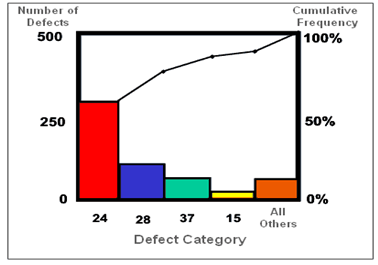What is Pareto Analysis and How it is Applied in Six Sigma Projects
What is the Pareto Principle ?
The Pareto Principle was an observation of a famous Italian economist named Vilfredo Pareto. He was trying to analyze the distribution of income amongst the population of Italy. That is when he observed that 80% of the income generated went to 20% of the population. He then began observing this 80/20 principle across nature. He observed that it seemed to be universally correct. This principle was named as the Pareto Principle in his honor.
The implications of the Pareto Principle are profound. The Pareto Principle states that doing 20% of the things right will give you 80% of the results you desire. It is a process of segregating the vital few from the trivial many and working on the vital few to get the best results. The words “vital few” and “trivial many” were at the center of the Pareto philosophy.
What is Pareto Analysis ?
Pareto analysis is a six sigma quality tool. It uses the Pareto Principle to find out solutions to business problems. As every manager would know, once you are put in charge of a certain department or work area, there are multiple problems that show up. In fact sometimes these problems are so many in numbers that it can be overwhelming for a manager to make any sense of the data that he/she may have at hand.
Thus managers use Pareto Principle and segregate the:
- 20% of the customers that provide 80% of the revenue
- 20% of defects which are the cause of 80% of customer complaints
- 20% of the activities which produce 80% of the defects
So on and so forth....

Figure: Pareto Analysis Lays More Emphasis On Cumulative Frequency To Segregate The Most Important Factors
How Can Pareto Analysis be Applied in Six Sigma Projects ?
Since the problem that every manager has to solve are unlimited. However the resources that he has in his hands are very much limited, resources need to be put to the best use. For this reason it is important that the resources be used to solve problems that will give the most benefit or reduce the maximum number of hassles.
Thus too ensure that the processes of an organization are defect free, one must first conduct a Pareto analysis, find out the most important causes, the chief factors that cause variation and correct them.
Pareto analysis is strongly recommended by management scientists who rely on data for decision making. They believe that the data is overwhelmingly in support of the validity of the Pareto principle.
| ❮❮ Previous | Next ❯❯ |
 Related Articles
Related Articles
- How to Create and Read a Pareto Chart ?
- How to Use a Fishbone Diagram
- RACI Matrix
- Creating A SIPOC Chart
Authorship/Referencing - About the Author(s)
The article is Written and Reviewed by Management Study Guide Content Team. MSG Content Team comprises experienced Faculty Member, Professionals and Subject Matter Experts. We are a ISO 2001:2015 Certified Education Provider. To Know more, click on About Us. The use of this material is free for learning and education purpose. Please reference authorship of content used, including link(s) to ManagementStudyGuide.com and the content page url.